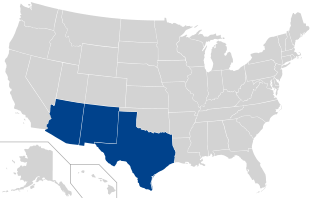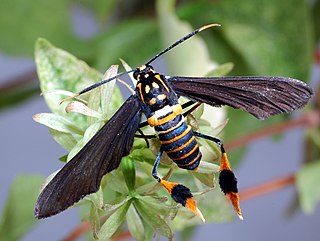
The Gadsden Purchase is a 29,670-square-mile (76,800 km2) region of present-day southern Arizona and southwestern New Mexico that the United States acquired from Mexico by the Treaty of Mesilla, which took effect on June 8, 1854. The purchase included lands south of the Gila River and west of the Rio Grande where the U.S. wanted to build a transcontinental railroad along a deep southern route, which the Southern Pacific Railroad later completed in 1881–1883. The purchase also aimed to resolve other border issues.

The Southwestern United States, also known as the American Southwest, Desert Southwest, or simply the Southwest, is the informal name for a region of the western United States. Definitions of the region's boundaries vary a great deal and have never been standardized, though many boundaries have been proposed. For example, one definition includes the stretch from the Mojave Desert in California to Carlsbad, New Mexico, and from the Mexico–United States border to the southern areas of Colorado, Utah, and Nevada. The largest metropolitan areas are centered around Phoenix, Las Vegas, Tucson, Albuquerque, and El Paso. Those five metropolitan areas have an estimated total population of more than 9.6 million as of 2017, with nearly 60 percent of them living in the two Arizona cities—Phoenix and Tucson.

The Border Conference, officially known as the Border Intercollegiate Athletic Association, was an NCAA-affiliated college athletic conference founded in 1931 that disbanded following the 1961–62 season. Centered in the southwestern United States, the conference included nine member institutions located in the states of Arizona, New Mexico, and Texas.
U.S. Route 180 is an east–west United States highway. Like many three-digit routes, US 180 no longer meets its "parent", US 80. US 80 was decommissioned west of Mesquite, Texas, and was replaced in Texas by Interstate 20 and Interstate 10 resulting in U.S. 180 being 57 miles longer than U.S. 80. The highway's eastern terminus is in Hudson Oaks, Texas, at an intersection with Interstate 20. Its western terminus is unclear. Signage at an intersection with State Route 64 in Valle, Arizona 40 miles (64 km) northwest of Flagstaff indicates that the route ends at SR 64, which is consistent with the AASHTO U.S. Highway logs. However, many maps continue the US 180 designation to the south rim of the Grand Canyon at Grand Canyon Village. Signage at the SR 64 intersection as late as 2011 indicated that US 180 continues north concurrent with the route. However, no signage along the route exists past this intersection until SR 64 turns east towards Cameron, Arizona. At this intersection, signage makes no mention of US 180 nor is there any mention at the terminus of SR 64 at US 89.

The Territory of New Mexico was an organized incorporated territory of the United States that existed from September 9, 1850, until January 6, 1912, when the remaining extent of the territory was admitted to the Union as the State of New Mexico, making it the longest-lived organized incorporated territory of the United States, lasting approximately 62 years.

Confederate Arizona, officially the Territory of Arizona, and commonly known as the Arizona Territory was an organized incorporated territory of the Confederate States that existed from August 1, 1861, until May 26, 1865, when the Trans-Mississippi Department, commanded by General E. Kirby Smith, surrendered at Shreveport, Louisiana. Effective Confederate control of Arizona Territory, however, ended after the Battle of Glorieta Pass in March 1862.
Ferguson Lake may refer to:
Rindgea is a genus of moths in the family Geometridae described by Alexander Douglas Campbell Ferguson in 2008.
Eulithosia is a genus of moths of the family Noctuidae erected by Henry Edwards in 1884.
Matigramma is a genus of moths in the family Erebidae. The genus was erected by Augustus Radcliffe Grote in 1872.
Stiria is a genus of moths of the family Noctuidae. The genus was erected by Augustus Radcliffe Grote in 1874.
Taeniogramma is a genus of moths in the family Geometridae erected by Paul Dognin in 1914.

Horama panthalon, the Texas wasp moth, is a moth of the subfamily Arctiinae. The species was first described by Johan Christian Fabricius in 1793. It is found in South America, Central America, Mexico, the Antilles and southern United States.

Syssphinx is a genus of moths of the family Saturniidae. The genus was erected by Jacob Hübner in 1819.
Yosemitia graciella is a species of snout moth in the genus Yosemitia. It was described by George Duryea Hulst in 1887. It is found in the US states of Arizona, California, Nevada, Colorado, New Mexico and Texas.
Digrammia pallorata is a species of moth in the family Geometridae. It was described by Douglas C. Ferguson in 2008 and is found in North America, where it has been recorded from Utah, Colorado, Nevada, Texas, New Mexico, Arizona and California.

Xerochlora viridipallens is a species of emerald moth in the family Geometridae. It is found in North America.

The indigenous peoples of the North American Southwest are those in the current states of Colorado, Arizona, New Mexico, Utah, and Nevada in the western United States, and the states of Sonora and Chihuahua in northern Mexico. An often quoted statement from Erik Reed (1964) defined the Greater Southwest culture area as extending north to south from Durango, Mexico to Durango, Colorado and east to west from Las Vegas, Nevada to Las Vegas, New Mexico. Other names sometimes used to define the region include "American Southwest", "North Mexico", "Chichimeca", and "Oasisamerica/Aridoamerica". This region has long been occupied by hunter-gatherers and agricultural people.









